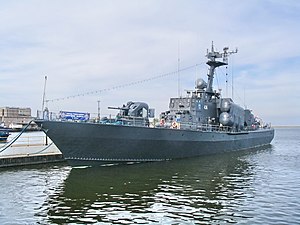Tarantul-class corvette

ORP Metalowiec, a Polish Navy Tarantul-I missile corvette in Gdynia
|
|
| Class overview | |
|---|---|
| Operators: | |
| General characteristics | |
| Type: | Missile corvette |
| Displacement: | 480 long tons (488 t) standard, 540 long tons (549 t) full load |
| Length: | 56.0 m (183.7 ft) |
| Beam: | 10.5 m (34.4 ft) |
| Draught: | 2.5 m (8.2 ft) |
| Propulsion: | 2 shaft COGAG turbines at 11000 hp each, plus 2 cruising engines at 4000 hp each (there were diesel and turbine versions of the cruising engines), |
| Speed: | 42 knots (78 km/h) |
| Range: | 1650 at 14 knots (26 km/h), operational autonomy for 10 days |
| Complement: | 50 |
| Sensors and processing systems: |
Radar: Spin trough, Bass Tilt, Peel pair, Pop group |
| Armament: |
|
The Project 1241 are a class of Soviet missile corvettes. They have the NATO reporting name Tarantul (not to be confused with the Stenka-class patrol boat, whose official Soviet name is also "Tarantul"). These ships were designed to replace the Project 205 Tsunami (NATO: "Osa") missile boats.
In the late 1970s, the Soviets realised the need for a larger, more seaworthy craft with better gun armament and higher positioned air search radars. The need for these improvements was underscored by the First Gulf War, when 12 Iraqi 'Osa-I's' were destroyed or damaged by short ranged Sea Skua anti-ship missiles. They were attacked by British Lynx helicopters, but the Osa crews didn't notice them because they flew below their radar horizon. In the Tarantul, both the single 76 mm main gun and the two 30 mm Gatling-type guns are used for air defence, together with a comprehensive electronic warfare suite. The boats are built by the Petrovsky yard (Leningrad), Rybinsk and Ulis yard (Vladivostok). A version of these ships for coastal anti submarine warfare and patrol was developed as the Pauk class corvette or Project 1241.2. The Indian navy paid approximately $30 million each to license-produce Tarantul-I in the early nineties. With over 30 sales on the export market the Tarantul has been a relative success for the Russian shipbuilding industry.
The naming convention for NATO reporting name Tarantul was a special case here. NATO called the first version of the class as Tarantul-II, given that they had a better sensor suite/equipment than the ships of the following class Tarantul-I, which was produced exclusively for export.
First version, based on the Pauk-class hull, though with a significantly increased weight. Equipped with four SS-N-2 'Styx' ship-to-ship missiles (either the 40 km range P-15 'Termit' missile or the later P-20 variant with 80 km range) and the associated 'Plank Shave' radar targeting system (45 km range in active mode of surveillance, 75–100 km range in passive mode, with an added air surveillance capability). 1 × AK–176 76.2 mm main gun and 2 × AK-630 30 mm six-barreled Gatling guns, the latter CIWS system supported by the 'Bass Tilt' targeting radar. Furthermore, there is a Fasta-N SA-N-5 quadruple MANPAD launcher and two PK-16 decoy launchers.
...
Wikipedia
